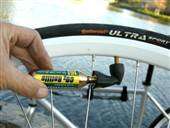Let's talk about road tires:
- Overinflated tires:
- Reduce rolling resistance but you'll need ultra smooth roads to notice any potential gains
- Give a harsher feel to your ride if you encounter bumps
- Will cause you to have handling/control problems
- Could damage the rims on your bicycle
- Increase rolling resistance, requiring more effort on your part to propel your bicycle
- Cause uneven wear patterns on your tires that could lead to premature failure

- 700 x 23 Tire size
- 12 gram cylinder will inflate up to 94 psi
- 16 gram cylinder will inflate up to 130 psi
- 25 gram cylinder - NOT recommended for road tire use
- 12 gram cylinder will inflate up to 90 psi
- 16 gram cylinder will inflate up to 123 psi
- 25 gram cylinder - NOT recommended for road tire use
The factors to consider when selecting tire pressure are:
- Rider weight
- What you weigh is important in determining air pressure. Don't worry so much about what the bicycle weighs before you get on it.
- There's a certain amount of deflection in every tire profile that's optimal for balancing grip, efficiency, comfort and durability. That deflection is based on the tire's construction and the weight of the rider.
- Unless you ride on perfectly smooth road surfaces you're going to have to account for the bone-rattling bumps along your route.
- The front and rear tire should be set at the same air pressure level.
- Never simply squeeze a tire to ascertain its pressure level. Invest in a good quality pump with a built-in gauge and/or a hand held bicycle tire pressure tool.
Use this handy chart as a good starting point for road bike tire pressures
Riders weighing below 100lbs-45kg should inflate to minimum pressure indicated on tire sidewall.
Riders weighing above 190lbs-86kg (***) should inflate to maximum pressure indicated on tire sidewall.
Rider weight (lbs-kg) | Clincher 700x28/32c | Clincher 700x25c | Clincher 700x23c | Clincher 700x20c | Clincher 650x23c |
| 100lbs-45kg | 58 psi(4 bar) | 73 psi(5 bar) | 87 psi(6 bar) | 87 psi(6 bar) | 87 psi(6 bar) |
| 110lbs-50kg | 58 psi(4 bar) | 73 psi(5 bar) | 87 psi(6 bar) | 87 psi(6 bar) | 87 psi(6 bar) |
| 120lbs-54kg | 62 psi | 77 psi | 91 psi | 91 psi | 91 psi |
| 130lbs-59kg | 66 psi(4.5 bar) | 81 psi | 95 psi(6.5 bar) | 95 psi(6.5 bar) | 95 psi(6.5 bar) |
| 140lbs-64kg | 72 psi | 87 psi(6 bar) | 101 psi | 101 psi | 101 psi |
| 150lbs-68kg | 76 psi | 91 psi | 105 psi | 105 psi | 105 psi |
| 160lbs-73kg | 80 psi(5.5 bar) | 95 psi(6.5 bar) | 109 psi(7.5 bar) | 109 psi(7.5 bar) | 109 psi(7.5 bar) |
| 170lbs-77kg | 85 psi | 100 psi | 114 psi | 114 psi | 114 psi |
| 180lbs-82kg | 87 psi(6 bar) | 102 psi(7 bar) | 116 psi(8 bar) | 116 psi(8 bar) | 116 psi(8 bar) |
| 190lbs-86kg | 95 psi(6.5 bar) | 109 psi(7.5 bar) | 118 psi | 118 psi | 118 psi |
| 200lbs-90kg | *** | *** | *** | *** | *** |
| 210lbs-95kg | *** | *** | *** | *** | *** |
| 220lbs-100kg | *** | *** | *** | *** | *** |













